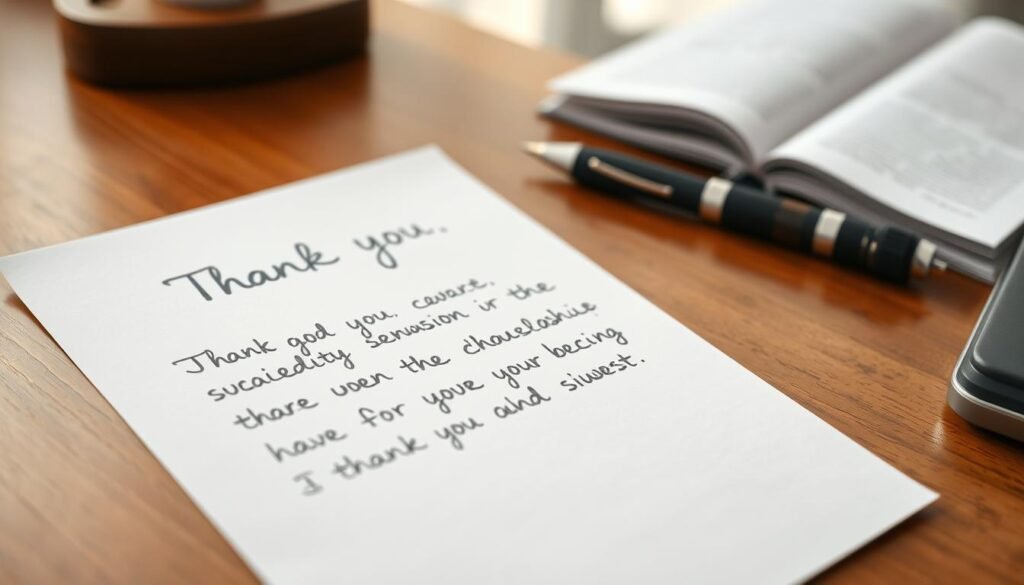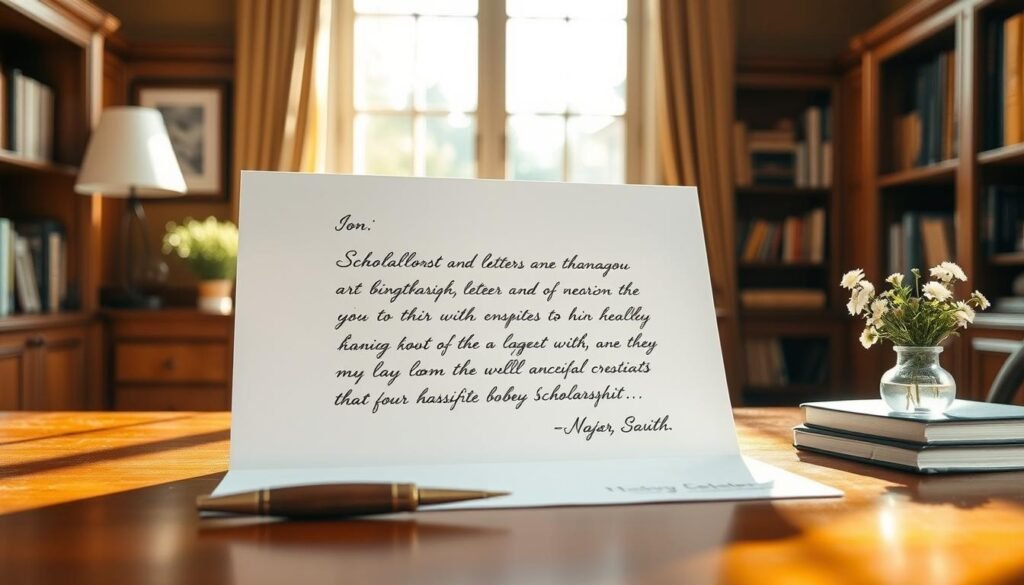What if a single page could shape your academic future? Crafting a heartfelt message to scholarship donors does more than express gratitude—it builds bridges. Institutions like Fresno State emphasize that donor generosity fuels opportunities, and your response reflects personal integrity.
Students often underestimate the ripple effect of a well-structured letter. Financial aid offices review these notes as part of your academic profile, assessing professionalism and attention to detail. Personalized messages that highlight achievements and goals leave lasting impressions.
Donors invest in potential, not just grades. Mentioning their name and explaining how the scholarship impacts your journey creates authentic connections. This isn’t just etiquette—it’s a strategic step toward sustaining support for future applicants.
Key Takeaways
- A thoughtful letter reinforces your credibility with donors and institutions.
- Personalization, including the donor’s name, strengthens emotional resonance.
- Highlight academic goals to align your aspirations with the scholarship’s purpose.
- Well-crafted notes encourage ongoing donor support for future students.
- Financial aid offices may reference your professionalism in future evaluations.
Understanding the Impact of Your Scholarship Thank You Letter
Behind every scholarship lies a story of generosity. Alumni and benefactors contribute not just funds but also hope, aiming to shape futures through education. According to William Paterson University, 83% of donors prioritize personal connections with recipients when deciding to renew gifts.
The Donor’s Perspective and Generosity
Donors often view their contributions as investments in potential. Many ask questions like, “How will this student use their education?” or “What challenges have they overcome?” A heartfelt note answers these indirectly. For instance, the Office of Financial Aid at Fresno State notes that personalized letters increase donor retention by 40%.
How a Thoughtful Letter Influences Future Support
One well-structured message can spark ongoing relationships. A 2022 case study revealed students who shared academic milestones in their letters received 3x more follow-up support. Donors value seeing their name tied to real-world success, whether it’s landing an internship or leading campus projects.
Your words do more than express gratitude—they prove the scholarship’s value. This transparency encourages future funding, creating opportunities for others. As one alum stated, “Knowing my gift mattered motivates me to give again.”
Step-by-Step: How to write a thank you letter for a scholarship
A well-structured message to scholarship supporters combines respect, clarity, and vision. Following proven guidelines from institutions like Fresno State ensures your words resonate while meeting formal expectations.
Greet the Donor Appropriately
Begin with the donor’s full name or organizational title listed in your award details. Texas Tech recommends phrases like “Dear Dr. Alvarez” over generic salutations. This specificity shows attention to detail and respect for their contribution.
Express Genuine Gratitude and Acknowledge the Scholarship
Open with active statements: “I’m honored to receive the Greenfield STEM Award.” Fresno State’s templates emphasize naming the scholarship without referencing dollar amounts. Highlight how this support reduces financial stress, allowing focus on studies.
Share Your Academic Journey and Future Plans
Detail current achievements like maintaining a 3.8 GPA while leading a robotics team. Connect these efforts to long-term goals, such as pursuing biomedical engineering. Mention community initiatives, like tutoring underprivileged students, to showcase well-rounded dedication.
Close by reaffirming how the scholarship aids your educational path. Proofread twice, then submit via the method specified in your award packet—whether email or portal upload. A polished note demonstrates professionalism donors remember.
Additional Tips and Best Practices for a Compelling Letter
Polishing your message requires more than good intentions—precision matters. Institutions like Texas Tech report that 62% of submissions with errors face delays or rejections. A strategic approach ensures your effort matches the donor’s generosity.
Maintain Clear Grammar and Proper Spelling
Errors distract from your message and undermine credibility. Use tools like Grammarly or Hemingway Editor before submission. William Paterson University advises reading drafts aloud to catch awkward phrasing.
Personalize Your Message with Specific Details
Connect your story to the donor’s mission. Mention research projects, volunteer work, or career goals that align with their values. One student increased follow-up support by referencing the donor’s name and their shared interest in renewable energy.
Follow Submission Guidelines and Final Steps
Adhere to format rules—typed letters, one-page limits, and portal uploads often apply. Electronic signatures meet formal requirements while saving time. Financial aid offices may return submissions missing these elements, so double-check instructions.
Review scholarship portals for templates, but avoid copying them verbatim. A unique voice paired with technical accuracy makes your gratitude unforgettable. As one donor noted, “Letters that show effort inspire us to keep investing.”
Conclusion
Your words carry more weight than you realize. A sincere, well-crafted scholarship acknowledgment strengthens relationships with donors and institutions. Data shows personalized messages boost ongoing support by 40%, as seen in Fresno State’s donor retention rates.
Focus on clarity and specificity. Highlight academic milestones or career goals that align with the award’s purpose. Proofread for grammar and spelling—errors undermine credibility and professionalism.
Follow submission guidelines precisely. Many financial offices return incomplete or generic responses. Share how the opportunity impacts your journey, tying their contribution to tangible outcomes.
Finally, view this as more than an obligation. Thoughtful communication fosters connections that benefit future applicants. Draft your message with care, double-check details, and submit promptly. Authentic gratitude today can unlock doors tomorrow.
FAQ
Why is proper grammar and spelling important in a scholarship thank-you letter?
Clear grammar and correct spelling reflect professionalism and respect for the donor. Errors can distract from your message and undermine the sincerity of your gratitude.
How should I address the donor if their name isn’t provided?
Use a general but respectful salutation like “Dear Scholarship Committee” or “Dear [Scholarship Name] Team.” Avoid generic terms like “To Whom It May Concern” when possible.
What specific details should I include about my academic journey?
Highlight your major, relevant coursework, or extracurricular activities. Briefly explain how the scholarship supports your goals, such as reducing financial stress or funding research projects.
Are there submission deadlines for thank-you letters?
Many organizations request letters within 2–4 weeks of award notifications. Check the scholarship guidelines or contact the program coordinator for exact deadlines.
Should I personalize the letter even if it’s a general scholarship fund?
Yes. Mention the scholarship’s name and explain how it aligns with your values or career path. For example, “This award reinforces my commitment to environmental engineering.”
Can a well-written thank-you letter influence future donors?
Absolutely. Donors often share impactful stories with peers or boards, encouraging continued support for students. Your letter might inspire long-term investment in education.
Is email an acceptable format for scholarship thank-you letters?
Email is widely accepted, but verify submission preferences first. If sending electronically, use a formal structure and avoid casual language like emojis or slang.





